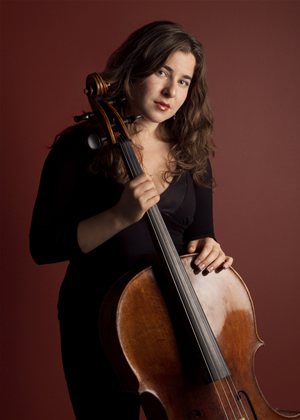Cellist Weilerstein provides intense advocacy for Golijov

The New World Symphony program served up last weekend provided a conspicuous example of just why the Miami Beach orchestra has become the leading classical music organization in South Florida.
Saturday night’s concert at the Lincoln Theatre offered the return of one of our top batonsmiths, Marin Alsop, a greatly gifted soloist in cellist Alisa Weilerstein, and the local premiere of an offbeat and compelling new work.
Osvaldo Golijov is one of the most regularly performed composers of our time. The Argentinian’s eclectic style freely mixes the Western classical tradition with a heterogeneous jambalaya of Latin, Jewish, pop and Middle Eastern influences, often featuring exotic instrumentation.
 I’ve had mixed feelings about many Golijov works, with the world-music elements, at times too self-consciously applied in a kind of free-form, politically correct musical diversity that often seems more opportunistic than musically cogent.
I’ve had mixed feelings about many Golijov works, with the world-music elements, at times too self-consciously applied in a kind of free-form, politically correct musical diversity that often seems more opportunistic than musically cogent.
Azul, however, performed Saturday night in its revised version by the New World Symphony and soloist Weilerstein, is one of Golijov’s more convincing and effective efforts. The cello concerto was written for Yo-Yo Ma and premiered by him in 2006 with the Boston Symphony Orchestra. Yet Golijov was dissatisfied with the contemplative work’s lack of contrast and substantially revised Azul with the close collaboration of Weilerstein, who premiered the new version in 2007.
Azul (“blue,” like the sky) takes its inspiration from many sources: nights the composer spent on the grass at Tanglewood looking up at the stars during performances, a Pablo Neruda poem, a sense of a bird in flight, and, the influence of Baroque music. The last is reflected in a retooled Nuevo Baroque continuo, with an accordionist and two percussionists manning such exotica as bottle shaker, waterphone, and “goat’s nail.”
Azul is now cast in four connected sections, with the opening Paz Sulfurica (Sulfuric Peace) presenting long meditative lines for solo cello that grow faster and more complex, joined by improvisatory writing for the percussionists. The ensuing Silencio movement is a chaconne, rendered Saturday with rapt spirituality by Weilerstein.
The third section, Transit, offers a kind of world-music jam session for the soloists, leading into the finale Yrushalem, with more soaring solo lines and a finale in which a single chord is repeated by cellist and orchestra as it fades into infinity.
Not everything works, particularly the coda, which on Saturday felt more inconclusive than consolatory. Also, Golijov’s ecstatic passages for solo cello and strings at times bear an unsettling resemblance to parts of John Tavener’s The Protecting Veil.
Still this is one of Golijov’s more successful works of recent vintage, with the percussion instruments more cohesively woven into the musical argument. Weilerstein’s performance was a tour de force, the soloist playing with an unearthly array of colors and dynamics, and seguing energetically into the rock riffs with percussionists Jamey Haddad and Keita Ogawa, with Michael Ward-Bergeman playing the “hyper-accordion.” Alsop and the orchestra provided comparably vital and stylish support. The applause brought Weilerstein back for a fiery Piazzolla-esque tango-flavored encore with the other soloists.

In her first return to the New World Symphony since taking the reins as music director of the Baltimore Symphony Orchestra, Alsop again displayed her brand of smart and incisive direction in two Romantic works.
Liszt’s tone poems in general and Les Preludes in particular, seem to have been retired from regular concert-hall appearances, with the latter’s grandiose heroics seeming a bit empty and dated in our down-sized, un-heroic era. Alsop’s concentration on detail sacrificed some forward momentum in a discursive work, yet she skillfully pared down the bombast to reveal the tone poem’s attractive melodic elements.
Conversely, in Dvorak’s Symphony No. 7, which concluded the evening, Alsop seemed intent on playing up the drama and volume. The conductor’s ongoing Dvorak cycle for the Naxos label has won consistent praise and Alsop, for the most part, showed herself a stylish and idiomatic Dvorakian.
While the work has its bucolic qualities and lyricism in Dvorak’s best folk-tinged vein, the Seventh is a leaner, darker work, arguably Dvorak’s finest essay in the genre, with a toughness and dramatic bite beyond the national Bohemian flavor.
Alsop drew an aggressive, no-nonsense performance that firmly underlined the drama yet at times missed out on the moments of compensating lyricism, with the Scherzo more emphatic than graceful and tuttis that turned a bit raucous. Still, it was a worthy performance and Alsop drew responsive playing from the orchestra with characterful wind solos and glorious contributions from the horn section.
Posted in Uncategorized
Leave a Comment
Sun Apr 12, 2009
at 3:03 pm
No Comments


